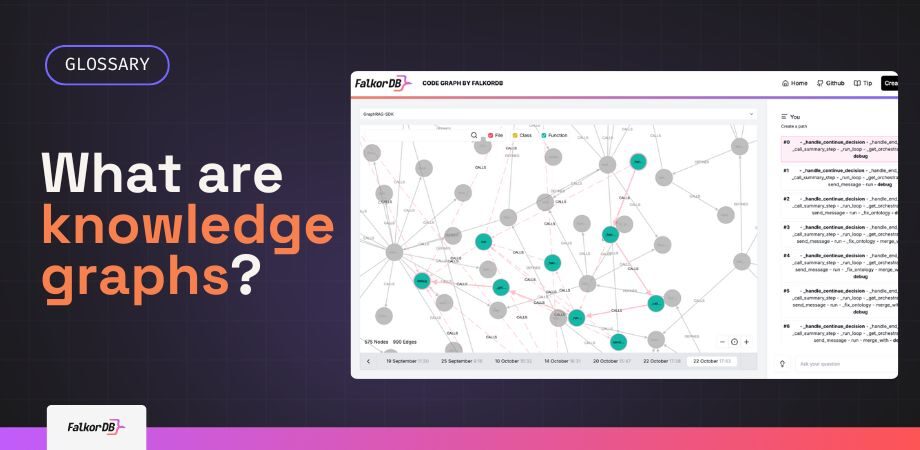- Knowledge graphs reduce LLM data dependency and improve explainability through structured context.
- GraphRAG uses knowledge graph traversal to outperform vector search in precision-critical tasks.
- Developers can use FalkorDB and LangChain to operationalize domain-specific knowledge pipelines.
What is a knowledge graph?
A knowledge graph (KG) is a graph-structured data model that represents entities and the relationships between them. Unlike other databases that treat data as rows and columns, a KG links entities (nodes) using typed relationships (edges) to model domain-specific or general-purpose knowledge.
The term gained popularity with Google’s 2012 announcement of its own Knowledge Graph, but the approach has roots in earlier fields such as knowledge representation, ontologies, and the semantic web
Why Developers Use Knowledge Graphs
Knowledge graphs support:
Contextual enrichment of unstructured and semi-structured data.
Data integration across systems by connecting disparate identifiers.
Explainability in AI systems by surfacing connections and reasoning steps.
Efficient retrieval using graph traversal and subgraph matching.
In practical AI and data science pipelines, KGs are used to reduce the dependency on labeled datasets, improve transfer learning outcomes, and provide context to machine learning models.
“Combining symbolic and sub-symbolic approaches is the only scalable way to create explainable, adaptive AI systems.” — Dr. Pedro Domingos, Professor, University of Washington
What Makes a Graph a Knowledge Graph?
A graph becomes a knowledge graph when it meets three conditions:
Graph-structured
Nodes represent entities; edges represent relationships.
Semantic schema
Ontologies define types, attributes, and rules.
Mutable and evolving
New facts, entities, and schemas can be added continuously.
This trifecta makes knowledge graphs highly adaptive and suitable for both static knowledge representation and real-time reasoning.
Building and Maintaining Knowledge Graphs
Constructing a production-grade knowledge graph typically involves:
Schema definition: Ontologies define the entity types, properties, and relationships.
Ingestion pipelines: Natural Language Processing (NLP) and Extract-Transform-Load (ETL) systems pull data from structured (SQL, CSV) and unstructured (HTML, PDFs, logs) sources.
Entity resolution and linking: Systems resolve duplicates and link entities across datasets.
Quality control: Confidence scores, provenance tracking, and human validation loops.
Reasoning and inferencing: Rule-based or statistical methods infer new facts.
Knowledge Graphs in Human-AI Interaction
In human-facing applications—search, chatbots, explainable AI—KGs support:
Structured explanations from graph traversal paths.
Entity disambiguation in user queries.
Real-time linking of information during conversations.
For example, a financial assistant bot can use a KG to:
Link a user query about “market volatility” to news, portfolio impact, and historical data.
Surface related topics like “interest rate changes” or “inflation risk.”
Developer Tooling and Frameworks
FalkorDB – High-performance graph database optimized for retrieval tasks (docs)
LangChain – LLM orchestration framework
SPARQL / Cypher – Query languages for RDF and property graphs
RDFLib / pySHACL – Python libraries for RDF data validation
What is a knowledge graph in software architecture?
How do knowledge graphs improve LLM performance?
What tools are used to build a knowledge graph?
Build fast and accurate GenAI apps with GraphRAG SDK at scale
FalkorDB offers an accurate, multi-tenant RAG solution based on our low-latency, scalable graph database technology. It’s ideal for highly technical teams that handle complex, interconnected data in real-time, resulting in fewer hallucinations and more accurate responses from LLMs.



